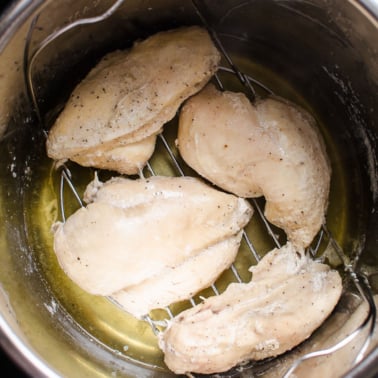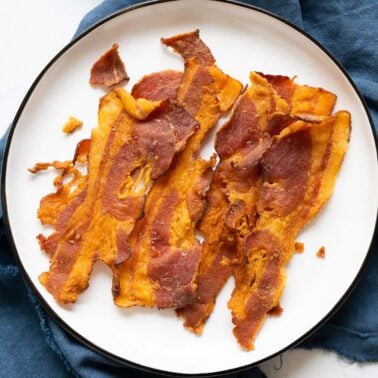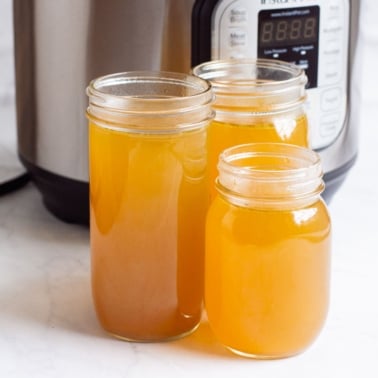Learn How to Make Almond Flour at home with just one ingredient in your food processor or high-speed blender. You can do so with whole raw almonds or store-bought blanched almonds. Almond flour recipe is easy, cheaper and convenient.
If you bake gluten-free, you might also enjoy this homemade oat flour tutorial.

Table of contents
I am an avid almond flour baker and I just love almond flour! I do not follow keto or low-carb diet, I just love cooking with almond flour.
I have so many recipes made with it, that I compiled a collection of 20 almond flour recipes. The most common feedback I get is that almond flour is expensive and I get it. I shop at a wholesale store, so it is not that bad.
But let’s explore how to make almond flour at home and if it’s cheaper and worth it indeed.
What Is Almond Flour?
So, what is almond flour made of? Almond flour is basically whole almonds processed in ground almonds with very fine texture. You can do so in a food processor or high speed blender. It can also be done in a coffee grinder in small batches, which is more time consuming but doable.
Almond flour is not and does not behave like regular flour. It doesn’t contain gluten, therefore it doesn’t rise the same way. Because almond flour is made from one main ingredient, almonds, it is full of healthy fats and protein.
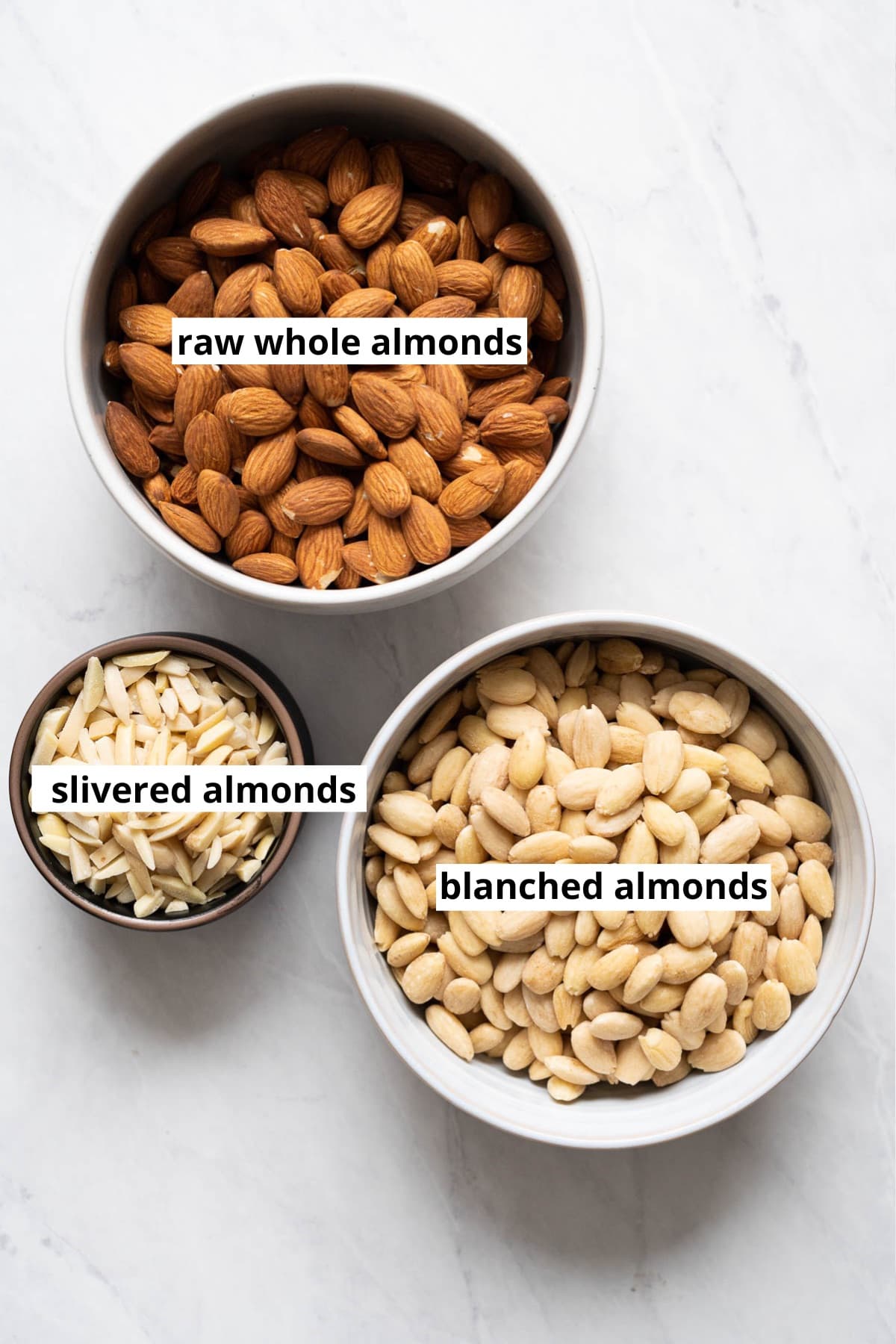
Types of Almonds You Can Use
- Raw whole almonds, with skin on and unsalted: These are basic regular almonds that have been harvested from the tree and not processed.
- Blanched almonds: Whole almonds with skins removed, light in color.
- Slivered Almonds: Sliced blanched almonds into long strips, like matchsticks.
- Sliced almonds: Not pictured but these are thinly sliced lengthwise raw almonds.
Is Almond Meal the Same as Almond Flour?
Main difference between almond flour and almond meal is that almond flour is made from blanched (peeled and white) almonds, and almond meal is made from whole raw (unpeeled and brown) almonds with their skin on.
How do you know which is which? Almond flour has fine texture and light color, and almond meal is more coarse with brown speckles.
So, if you compare almond flour versus almond meal, they are not exactly same thing.
When to Use Almond Meal vs. Almond Flour?
You can use almond flour and almond meal interchangeably in more forgiving quick bread and cookies recipes. But for recipes that are more delicate and their success relies on a fluffy texture, think cake with almond flour and almond flour pancakes, it is better to use almond flour. It has lighter flavor, color and texture.
Almond meal is great to use in place of breadcrumbs for coating chicken or making a crunchy casserole topping. Recipe examples where we used almond meal, would be this almond crusted chicken, healthy fish tacos and healthier sweet potato casserole.
Bottom line is you can use almond meal instead of almond flour if you have to, just expect less rise and fluff.
How to Make Almond Flour in a Food Processor
Making your own homemade almond flour requires 1 ingredient, a small kitchen appliance and 5 minutes. Before you begin, you need to consider what kind of almonds and an appliance you have.
- Regular raw almonds or blanched almonds, slivered almonds
- Food processor or high-speed blender like Blendtec, Vitamix or Ninja
How to Blanch Almonds
If you have unpeeled almonds and need to remove their skins, here is a quick tutorial how to blanch almonds.
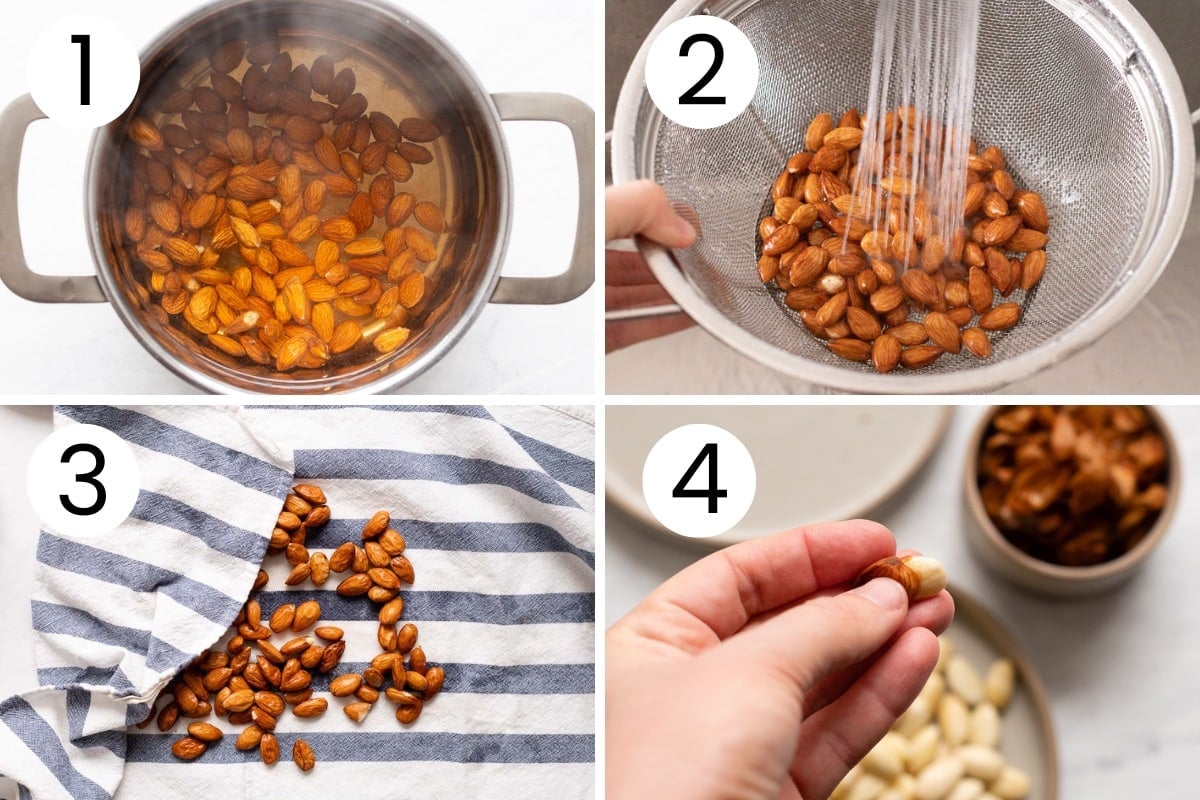
- In a large pot, bring water to a boil and turn off heat.
- Add almonds, spread them evenly and leave them in boiling water just for 1-2 minutes.
- Drain in a colander, rinse with tap cold water and drain again.
- Spread on a towel in a single layer and dry well. Their skin will be shriveled at this point.
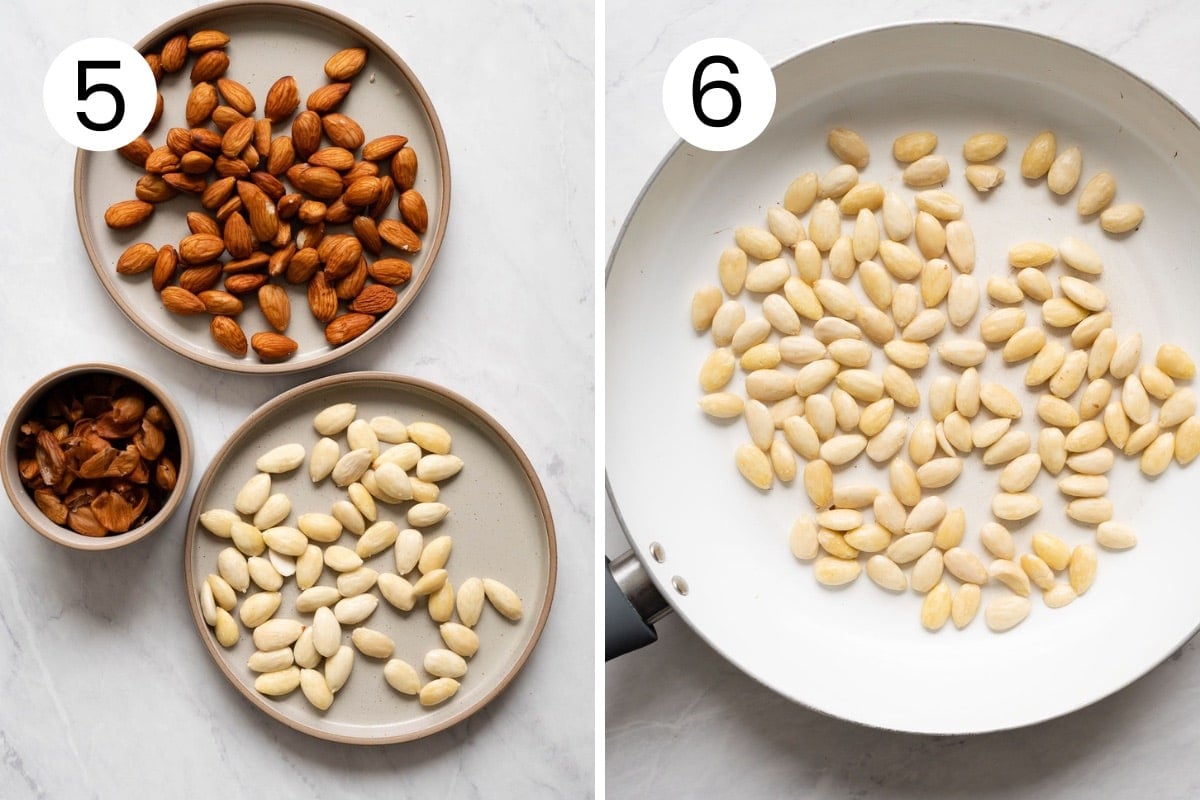
- Peel the skin off of almonds with your hands. It should come off easily. Discard almond skin.
- Now you want to dry your blanched almonds before making an almond flour. Place them in a large skillet in a single layer and toast for about 5 minutes, until they look dry and moist free. Stir a few times and do not cook them until they start to turn brown.
Recipe Tip
To dry out skinned almonds, you can also spread them on a baking sheet and roast at 250 degrees F for about 3-5 minutes.
Now you are ready to make your own almond flour in a food processor. Here is how:
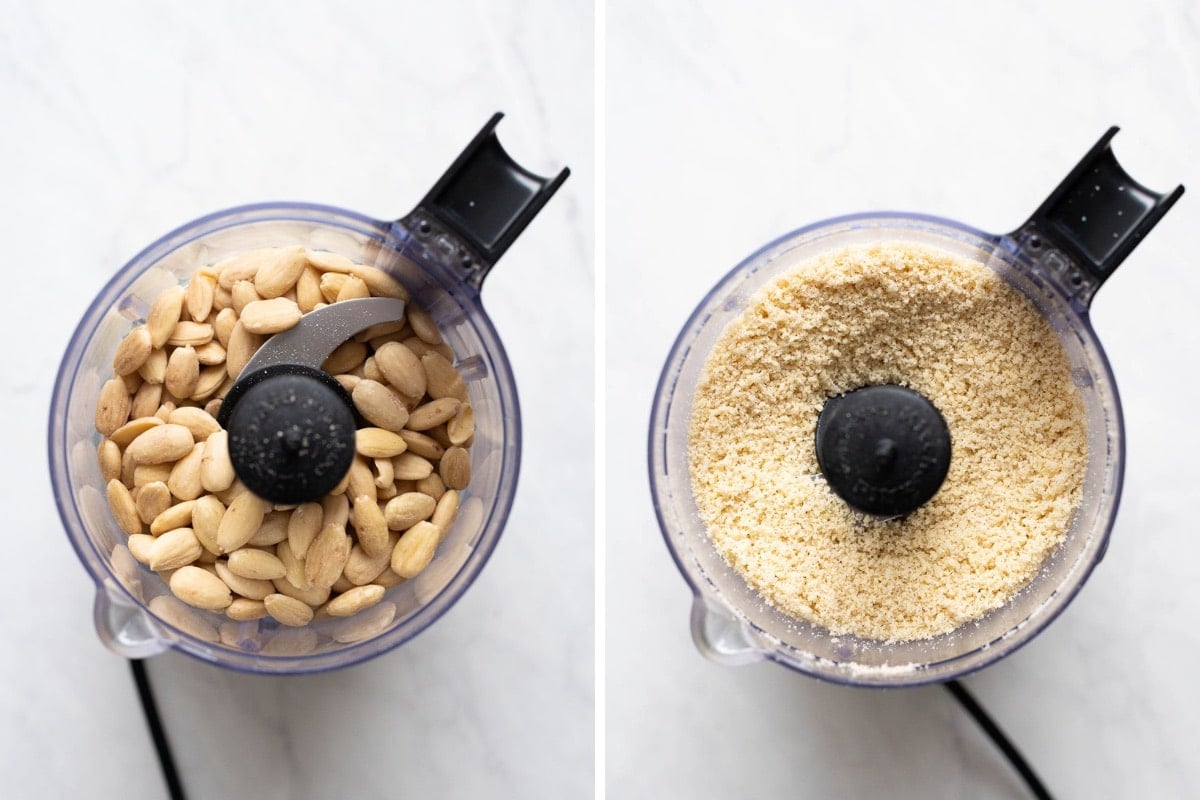
- Add 1 cup of almonds to a bowl of food processor fitted with an S blade attachment.
- Pulse them in intervals of 10 seconds for a total of 50 seconds. The key is to make sure the bowl of food processor doesn’t get hot from one long streak of processing.
- Then open the lid and scrape the bottom and the walls. It is important to mix it all up, so almonds do not start releasing the oil and turning into almond butter.
- Pulse for another 20-30 seconds in 10 seconds intervals.
How to Make Almond Flour in a High Speed Blender
Before you begin, I would like to note that regular, not high powered blender, will not work to make almond flour. In that case, I recommend you use a food processor.
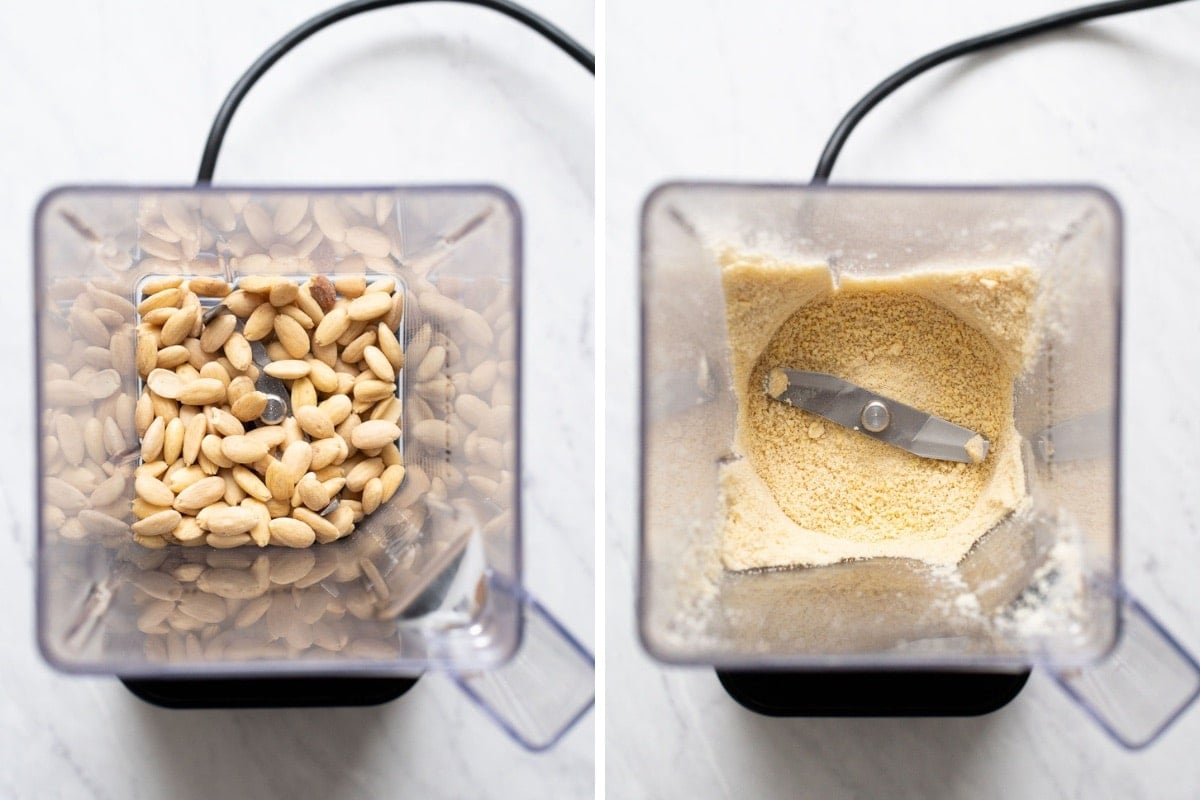
- Add almonds to a blender jug. I am using my old Blendtec.
- Blend in 10 seconds increments, about 3 times or until you see fine powder forming.
- Open the lid, scrape the walls and bottom of the jug with long wooden spoon.
- Continue pulsing in 10 seconds increments again, scraping the walls and bottom every 10 seconds. For another 20 seconds or so. Blender becomes very hot very fast, so do not overprocess.
Recipe Tip
Store-bought almond flour is usually super fine almond flour. If yours turns out more coarse, it is OK. Some blenders and food processors can do only so much. It’s better to have that than almond butter.
How Much Almond Flour Do You Get?
A million dollar question is “How much almond flour does 1 cup of almonds make?”. Before we talk whether it’s worth to make it at home, let’s talk about how much of it do you get.
Blanched almonds:
- 1 cup of blanched almonds weighs 5 ounces or 140 grams
- 1 cup of blanched almonds yields 1 1/3 cups of almond flour
- 1 cup of almond flour weighs 3.5 ounces or 100 grams
Slivered almonds:
- 1 cup of slivered almonds weighs 4.3 ounces or 120 grams
- 1 cup of slivered almonds yields 1 1/4 cups of almond flour
- 1 cup of almond flour weighs 4.2 ounces or 120 grams
Is It Cheaper to Make It at Home?
So, is it worth it to make your own almond flour at home vs. buying it at the grocery store or online. The answer is “it depends”. Depends on where you live, and current market situation at time of writing this post. Also depends how much time you have on your hands because time is money.
Let me show you my calculations and you can do the same for your own region.
- 3 lbs or 1.36 kg bag of almond flour costs $18 at Costco (wholesale supermarket)
- 3 pounds = 1,360 grams. Since there is 3.5 oz (100 grams) in 1 cup of flour, it costs $1.36 per 100 grams.
- Store-bought blanched almonds at my local grocery store cost $2.19 per 3.5 oz (100) grams.
- Since to make 1 cup of almond flour we need 3.4 ounces (95 grams) of blanched almonds, the cost of 1 cup of homemade almond flour for me would be $2.08. Not worth it!
So, the verdict is that for me shopping in this grocery store is not worth the savings to make almond flour at home. However, for you it might be, if you can buy almonds cheaper. Same for me. There are many different situations and you can do a fun math for yourself.
How to Store It
So, how long is almond flour good for? It depends. Let’s go over various scenarios.
Almond flour should be stored in a cool dry pantry, fridge or freezer. Light and heat are the enemy of nuts, dark place is their friend. Unopened bag of almond flour will last 2-4 months in the pantry and 6-12 months in a fridge. You can freeze it indefinitely!
Opened bag or DIY almond flour should be stored in well-sealed container or in an airtight container for up to 1 month. After that, refrigerate it.
Recipes and Uses
I have such a variety of almond flour recipes here on the blog! You can use it in a variety of ways.
Quick breads and muffins: Using this ingredient to make quick breads and muffins is my favorite way! And kids love this type of baked goods. Most popular recipes on the blog is this banana bread with almond flour and almond flour banana muffins.
Cookies and cakes: It yields great texture in these healthier versions of almond flour chocolate chip cookies and almond flour carrot cake.
Crusts: It is a great gluten-free alternative for crusts of all kinds. Just look at this almond flour pizza crust. Or this rich and gooey crust in healthy lemon bars and healthy pecan pie bars.
Savory dishes: In my experience, best way to replace wheat breadcrumbs is with almond flour or almond meal. I have successfully done so with healthy chicken nuggets, lemon chicken and even baked chicken parmesan.
FAQs
Yes, almond flour is grain-free and gluten-free flour that does not contain wheat or gluten. Therefore, it is great alternative for those with celiac disease.
Yes. Almond flour is keto-friendly flour because it contains only one ingredient which is almonds. Nut are allowed when following keto diet.
Yes. Ground blanched almonds, almond powder are other common names for almond flour. Ground almonds with skin on are almond meal.
1 cup of blanched almonds yields 1 1/4 cups of almond flour.
Yes and no. For best results use recipes developed with almond flour. Almond flour has more fat and no gluten compared to wheat flour. Therefore, you will need to add more eggs and use more almond flour. Final product will have different texture, taste and appearance. It also depends which recipe it is.
We have a plethora of almond flour recipes here on the blog. Many classic dishes have been adapted to use almond flour.
Healthy means a different thing for everyone. It is full of healthy fats, vitamins and minerals. You are basically eating nuts. However, everything is good in moderation and it depends how you cook with almond flour.
When it comes to store-bought flour, I personally have tried and recommend is Kirkland and Bob’s Red Mill brands. 99% of my recipes are made with Kirkland one.
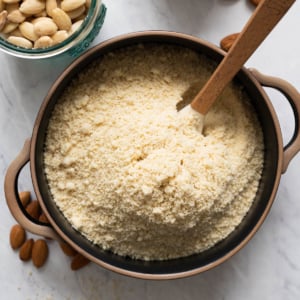
How to Make Almond Flour
Equipment
Instructions
To make almond flour in a food processor:
- Add 1 cup of almonds to a food processor with an S blade attachment. Pulse in intervals of 10 seconds 5 times, open the lid and scrape the walls and bottom of the bowl. Put the lid back on.
- Continue pulsing for another 20-30 seconds in 10 seconds intervals until fine almond flour forms. Stop as soon as you see fine powder and avoid over processing into almond butter.
To make almond flour in a blender:
- Add 1 cup of almonds to a high speed blender and pulse in 10 seconds increments about 3 times.
- Open the lid, scrape the walls and bottom with long wooden spoon and continue pulsing in 10 seconds increments, scraping the walls every 10 seconds. Do so until you see fine powder forming, for another 20 seconds or so.
Notes
Nutrition
Nutrition information is automatically calculated, so should only be used as an approximation.

